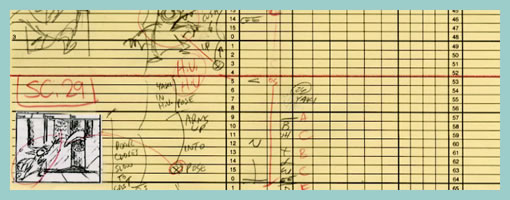Exposure Sheets (X-Sheets)
January 22nd, 2010
Traditional animators have been relying on sketching techniques of their own which I thought might be inspirational. Animators represent time with exposure sheets (aka. dope sheets) through which a large number of information can be conveyed to others. An x-sheet is pretty much a frame by frame representation of time to which notes can be layered on top. Some of these notes typically include information about: dialogue, camera angles, lighting, background and audio. Since timings of around 30 frames per second are standard, each xsheet is just a snapshot of a few seconds. Nevertheless, animators still find them useful as a communication artifact.
Here is what the people at Michael Sporn Animation studios have to say about these deliverables:
You see, when you get used to reading X-sheets, you see them as time. You don’t see the lines, you see seconds and footage, instantaneously. As an animator, you get an overview immediately of the scene; as a director you read the track, how the animator has constructed the scene, and what camera moves are indicated and why.
Here are a couple extra x-sheet samples.
Of course x-sheets work for a passive medium such as film and it’s questionable of how useful they might be for interactive web applications. Nevertheless, I still wonder if some of these ideas can be useful to our field. What other information can experience or interaction designers “layer” on top of the existing deliverables that we are typically accustomed to? Perhaps it would be interesting to combine a user flow representation with a learning curve or effort representation? What ever happened to representing sound in a UI sketch? What about a wireframe referencing an x-sheet sketch for the times when we do use animation? Hey, and what about a user flow with one axis dedicated to representing time consistently? Just thinking out loud.
Credits: Jun Falkenstein
























January 23rd, 2010 at 8:38 am
A very inspiring form of capturing time! As you already pointed out, the consumers would need some sort of education as to make x-sheets a communication deliverable. But using the x-sheet as input, some tool could read and display the wanted information in an animation …
January 24th, 2010 at 3:04 pm
We need more easy ways of expressing the subtleties of certain interactions.
I'd like to see a breakdown of how the various columns in a typical exposure sheet are used.
January 28th, 2010 at 2:38 am
Xsheets (aka dope sheets) are the model for the timeline of Flash, AfterEffects, and just about any digital animation tool out there. I had a whole previous career in animation, and I spent many long days reading xsheets in order to shoot pencil tests (video tape!) or to digitally composite scenes.
Xsheets are more effective for documenting the exact detail of movement and transition than they are at communicating the big idea. That's why they're often accompanied by storyboard panels or thumbnail sketches of camera movement.
As an interaction designer, I would consider using the xsheet approach if I needed an extremely accurate spec for an developer to code against. Maybe for geo-dispersed teams. But then there's the hurdle of educating a developer on how to read one.
My preference would be to storyboard timebased interactions. Storyboards with annotation can communicate both the big idea and the detail between. And if your developer is accessible and doesn't mind collaborating a little, you can refine the animation with them in real-time.